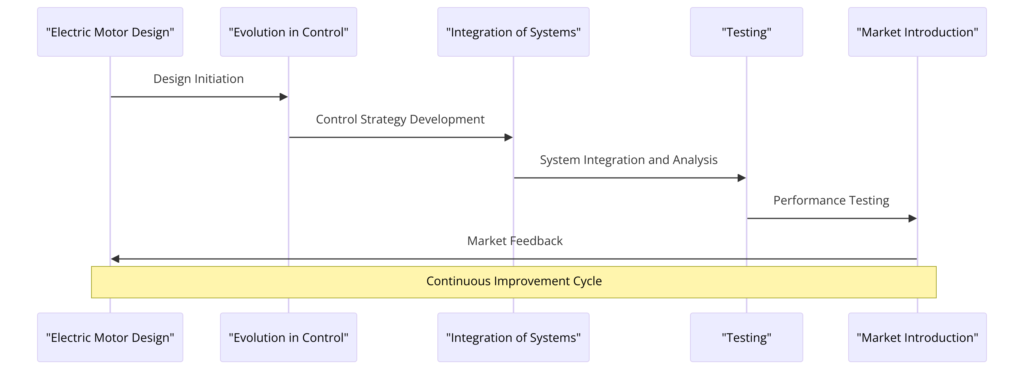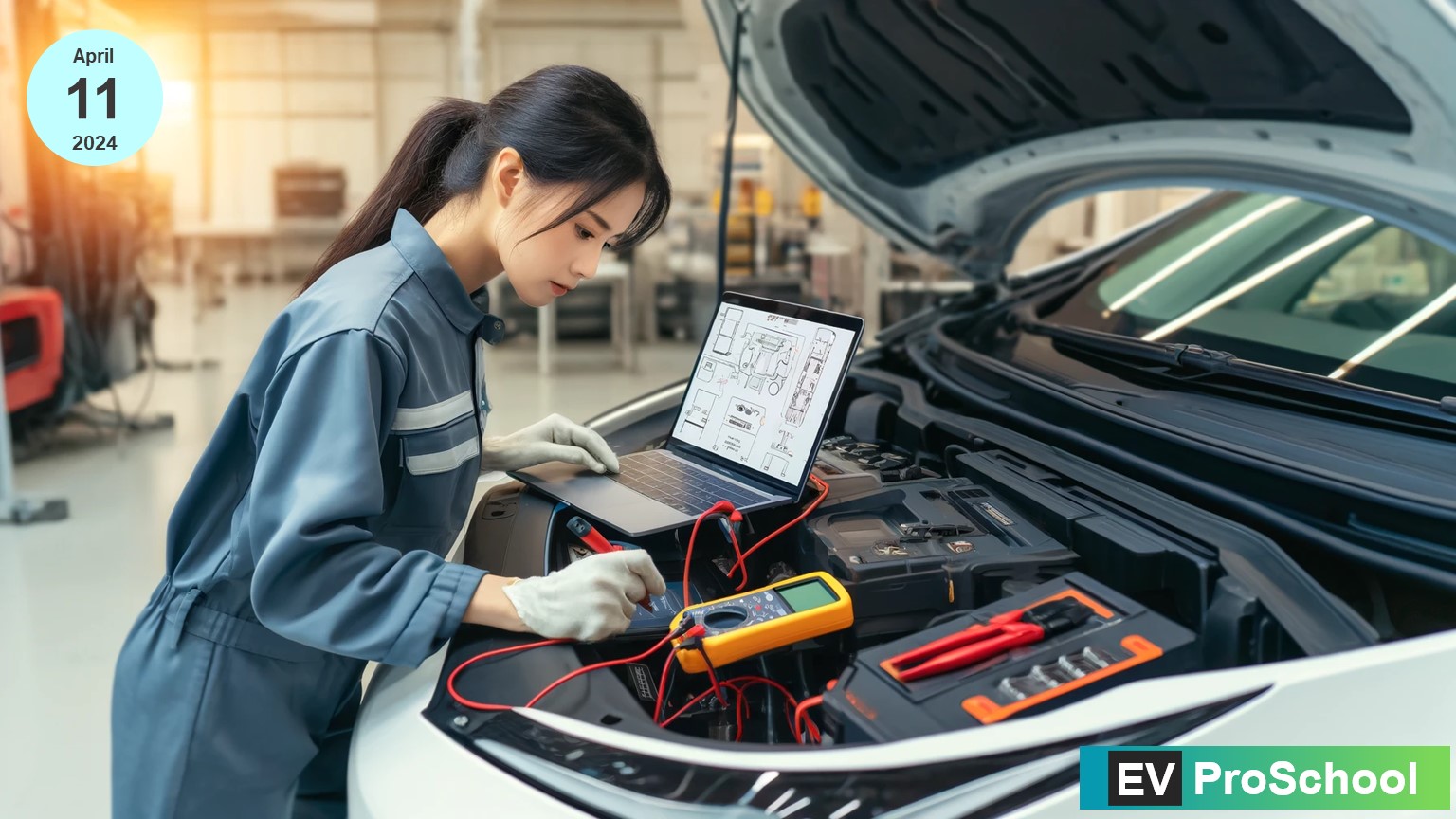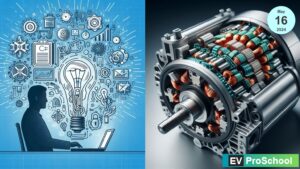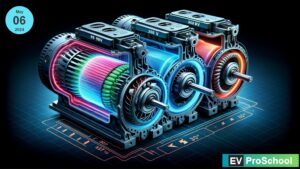In the ever-evolving landscape of electric mobility, EV motor technology is rewriting the technological strides. With the advent of electronics, the implementation of advanced control strategies like field-oriented control (FOC) has become possible. Electric motors in EVs have taken a new leap in the 21st century.
This new-age EVs competes with the High-end ICE vehicle performance. Tesla Roadster achieves 0~100 km/h (0 to 60 mph) in 1.9 seconds. whereas Ferrari cars are known for their speed and performance, with models like the SF90 Stradale reaching 60 mph in under 2.5 seconds.
This blog post will swiftly take you from the basics of electric motors to advanced technology and how it contributes to performance. For EV lovers and industry professionals, there is a detailed comparison of motors and their types used in the market.
1. Introduction to EV Motor Technologies
Begin with the tale of a young engineer named Maya who joined an EV startup. On her first day, she’s taken to the testing lab where several motors are being evaluated. Each one represents a different era of electric vehicle development – from the simple DC motors in early EVs to the advanced units powering today’s vehicles. Through Maya’s eyes, introduced the basic concept that different motor types solve different problems.
2. DC vs. AC motors
How Electric Motors Work, Basics of electromagnetic induction, Key components: stator, rotor, windings, and power sources Differences between AC and DC motors
Direct Current (DC) Motors
Construction and working principle Applications in variable-speed industrial setups and automotive systems Video: Construction, Purpose, and Function of DC Motor in Automobiles
Limitations of DC Motors
Higher Cost: Manufacturing complexity due to commutators and brushes
Elevated Rotor Inertia: Reduced responsiveness to speed changes
Maintenance Issues: Brushes and commutators wear out over time
Speed and Peak Current Limitations: Constraints on high-speed operation
Electromagnetic Interference (EMI): Commutation process introduces EMI concerns
Alternating Current (AC) Motors
describe the various AC motors. Induction Motor, Synchrnous motor. IPSM motors.
Comparison of DC Vs AC Motors
2. Electric Motors in EVs
which motor to use in EV actually depends upon the types of EV is being USD. However in EV now a days most of the OEM are using PMSM motors.
Permanent magnet motors have become increasingly popular in electric vehicle applications, thanks to their high efficiency and power density. The utilization of permanent magnets in the motor’s rotor eliminates the need for electrical energy to generate magnetic fields, significantly reducing energy losses. However, the design and control of these motors present unique challenges, including the management of heat and the optimization of magnetic materials. Ongoing advancements in material science and thermal management techniques are crucial for unlocking the full potential of permanent magnet motors in EVs.

Unique Features of IPMSM
- High-speed operation and robustness
- Video: Generator Exciter Air Gap & IPM Motor Rotor-Stator Structure
The Role of Air Gap in Motor Performance
- Direct and quadrature axis variation (Ldm < Lqm)
- Effects on motor torque and efficiency
Armature Reaction in IPMSM
- Demagnetization Effect: Reduction in torque due to stator flux
- Cross-Magnetization Effect: Distortion in rotor flux leading to torque ripples
Auxiliary Time Sweep Analysis
- Step-by-step rotor analysis for performance optimization
- Evaluating torque ripples, iron losses, and efficiency
Comparison of Types of motors being used in two wheeler applications in Indian Industry.
Emerging Trends in EV Motor Technology
The Significance of Motor Ontology
Motor ontology provides a comprehensive framework for categorizing and understanding the diverse aspects of electric motor design and functionality. By dissecting the core components and operational principles of various motor types, engineers and designers can pinpoint areas ripe for innovation. This methodical approach paves the way for targeted research and development efforts, ensuring that enhancements in motor technology directly translate to improved EV performance.
Electromagnetic Analyses: The Core of Motor Efficiency
At the heart of electric motor optimization lies electromagnetic analysis. This process involves scrutinizing the motor’s magnetic field interactions to maximize efficiency and minimize energy losses. In the context of electric vehicles, where efficiency is paramount, advanced computational tools and simulation techniques are employed to refine electromagnetic designs. The goal is to achieve an optimal balance between power output, energy consumption, and heat generation, ensuring that EVs can deliver on the promises of range, performance, and sustainability.

The Rise of Multiphase Motors
Potential for replacing traditional three-phase motors in EVs
Greater fault tolerance and smoother torque distribution
Looking Ahead: The Future of EV Motor Technology
The second edition of “Design and Control of Electrical Machines in Electric Vehicles” captures the essence of the current research and development landscape, highlighting the need for continuous innovation in motor technology. As the demand for electric vehicles grows, the push for more efficient, reliable, and powerful motors becomes increasingly urgent. Through dedicated research in motor ontology, electromagnetic analysis, multiphase motors, and permanent magnet designs, the future of electric mobility looks brighter than ever.
In conclusion, the journey of enhancing electric vehicle performance through advanced motor design and control strategies is an ongoing one. The relentless pursuit of optimization across electromagnetic analyses, multiphase motors, and permanent magnet motors is not just about achieving technical milestones; it’s about shaping the sustainable future of transportation. As we turn the pages of “Design and Control of Electrical Machines in Electric Vehicles, 2nd Edition,” we’re not just reading about the future of EV technology—we’re driving it forward.



